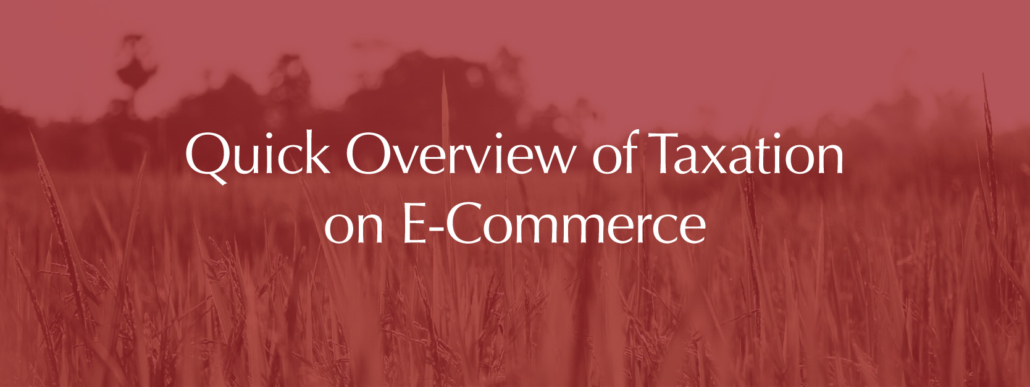Quick Overview of Taxation on E-Commerce

E-commerce is a fast-growing industry both in our country and elsewhere, but taxes on e-commerce are a relatively complex subject that few people are familiar with. In order to keep e-commerce accounting accurate, you need to know how to calculate taxes and in which countries you pay taxes. This, in turn, depends on what your product is, how your product moves and who are the buyers.
The main factors affecting e-commerce taxation
- Physical or e-product – whether you sell physical goods (tableware, clothing, accessories, etc.) or electronic products (digital posters, e-books, video courses, etc.).
- How your goods move – whether you ship goods from Estonia to abroad, from China directly to a customer or use an EU intermediate warehouse.
- The buyers – whether they are individuals or legal entities, inside or outside the European Union.
E-commerce related taxes are also discussed in more detail in the article What You Need to Know About Amazon Accounting and Taxes. We will briefly refer to that article here.
VAT in Estonia and other EU countries
In Estonia, you are required to register for VAT, if:
- the taxable turnover in Estonia exceeds 40 000 euros per year
- you sell services/goods from Estonia to private individuals in the EU
- you purchase electronic services from abroad (for example, using Amazon, Facebook or Google services, web hosting, purchasing e-books, e-courses, etc.)
- you buy more than 10,000 items a year from EU countries.
The latter two – purchase of electronic services and the purchase of goods from the European Union above the threshold, require a limited VAT liability, which means that you will pay VAT on services purchased abroad but cannot refund the VAT on your domestic purchases. Therefore, when it comes to VAT liability, it is much wiser to immediately become a “regular” or fully entitled taxable person.
In another EU country, you will be immediately liable to VAT if you use intermediate warehouses in another EU country (such as the UK or Germany) or if your sales to private individuals, or distance selling by country, exceed a specific country limit (35-100K in each country). Accounting for e-shops that sell and pay VAT between several countries, can be quite complicated. Estonian accountants do not provide this service mostly. The easiest and often the cheapest option is to outsource this service from Amazon, for example. Robby&Bobby can also help you with UK VAT returns.
Special MOSS regime
You must apply the special MOSS regime if you sell electronic services to other individuals in the European Union and sales income exceeds 10,000 euros per year. If the sum is less, standard Estonian VAT will apply. When the amount reaches the limit, you register with the Tax Administration separately and apply VAT to the destination country, tracking where the shoppers are from (this can be done with a special plug-in for e-shops). You file a tax return to the Estonian Tax Administration on a quarterly basis and it is ultimately easier than being subject to VAT in each country as is the case with physical products.
Income tax
In certain cases, the country of origin of the payment is entitled to withhold income tax on your income. The specific rules vary from country to country, so you must familiarize yourself with them to avoid any surprises. In particular, withholding tax is levied on royalties, rents, dividends and interest as well as on e-products. For example, US payments to Estonia for the sale of e-products (such as e-books) are subject to withholding tax of 30%. If you have a local EIN, you can reduce it to 10%.
Corporate tax can become a topic if you have a local store in another country or a beauty salon there, for example. However, income tax liability may also arise if the members of the board of directors of a company registered in Estonia reside elsewhere – for example, a member of the board resides in Spain.
Sales tax
In US and Canada, you also need to be familiar with the concept of sales tax, which is different from the VAT we apply and is accounted for by state. In general, the US tax system is so complex that an Estonian accountant cannot help you here. And certainly do not expect the US tax authorities to turn a blind eye in some places – rules are very strict there.
Sale of physical goods
Taxes related to the sale of physical goods depend on whether you use Amazon for sale, dropshipping or export goods directly from Estonia.
In the case of US Amazon, merchandise moves from China to the US and you use the Amazon interim warehouse in US. In Estonia, you have to be at least a limited VAT payer as you buy advertising from Amazon. In US you need to consider sales tax in the state where the warehouse is located.
In case of UK Amazon, the goods move from China to Europe and the warehouse is located in Europe (UK or Germany). In Estonia, you have to at least be subject to a limited VAT liability because you buy advertising from Amazon. In the intermediate country, you need to become VAT liable starting from the first sale + observe the distance selling thresholds.
In case of dropshipping, the goods go directly from China to the buyer. Dropshipping is a major “tax hole” today as the countries treat the shipped goods as private packages and the buyer self-declares VAT and duty according to the value on the package of the goods, which is often unrealistic. This is likely to change since 2021.
In case of export from Estonia you have to observe who the buyer is and when sending the goods to a foreign country you have to prove that the goods actually left Estonia. For an Estonian buyer, regular Estonian VAT applies, for another EU individual retailer, follow the distance selling thresholds, for a corporate buyer, VAT is 0% (if you are given a VAT number) and other foreign buyers will also be charged 0%.
E-products for sale
An e-product has several names. E-product = electronic product = virtual product = electronic services (within the meaning of the VAT Act). For example, an e-book is also an electronic service. Also, video courses, apps, computer programs, music files and more.
NB! Affiliate does not belong to this classification! Affiliate is classified as an advertising service as you are selling the advertising service, not the product itself.
As to physical products, you can sell e-products on another platform or in your own online store. If you use a platform (like Amazon or Etsy), VAT is managed by the same platform. If you sell products from your own online store, the logic of MOSS applies. For an Estonian buyer, standard Estonian VAT applies, for a private individual from another EU country, initially also Estonian VAT applies, starting from 10,000 sales revenue (all countries included), VAT of destination country, for a legal buyer 0% VAT (if given a VAT number) and for other foreign buyers, also 0% VAT rate.
To conclude
E-commerce accounting requires knowledge of legislation and taxation in many countries. Tax accounting is most influenced by the e-commerce model you choose, whether you sell the product in physical or e-commerce, whether you use intermediate storage, ship products directly from China to a buyer, or export products from Estonia. Also the fact, what is the sales revenue per country and whether your products are purchased by individuals or other companies. In general, taxes on e-commerce are such a wide area that an entrepreneur is not advised to deal with it alone. Find an accountant with international e-commerce experience or order service from Amazon.

Leave a Reply
Want to join the discussion?Feel free to contribute!